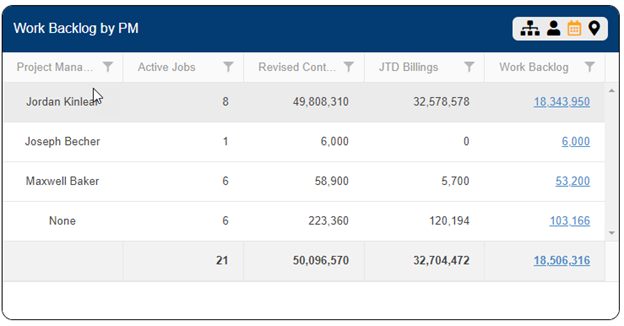In the dynamic world of construction, financial foresight is the cornerstone of success. The Work Backlog by Project Manager (PM) stands as a testament to this, offering a forward-looking snapshot of the workload and revenue that lies ahead. Let’s unpack the significance of this KPI, how it’s calculated, and the tangible impact it has on the day-to-day and strategic decision-making processes.
The Essence of Work Backlog
The Work Backlog KPI represents the volume of work secured via contracts but remains to be completed and billed. It’s not just a metric; it’s a predictor of future cash flow and a planner for resource allocation. As such, it’s a vital compass for any construction business aiming to navigate the ebbs and flows of project demand and financial health.
Components of Work Backlog:
-
- Project Manager (PM): The lead overseeing the projects.
- Active Jobs: The number of ongoing projects managed by each PM.
- Revised Contract Value (RCV): The updated value of the contracts post any amendments.
- Year-To-Date (YTD) Billings: The total billed to clients within the current year.
- Work Backlog: The monetary value of work that has been contracted but not yet billed or completed.
Calculating the Work Backlog
Here’s how you can compute this critical KPI:
Work Backlog = Original Contract Value + Approves Contract Changes + Pending Contract Changes – JTD Work Billed
This calculation gives you an estimation of the work that is guaranteed and yet to be done, translating into potential revenue.
Real-world Applications and Impact
Consider the following scenario:

Jordan Kinelar: With eight active jobs, a revised contract value of approximately $49.8 million, and a work backlog of over $18 million, this substantial backlog figure indicates a strong pipeline of work. It underscores the importance of efficient project and financial management to ensure profitability.
Joseph Becher: Managing one job with a $6,000 contract, equating to a smaller backlog, suggests either a project early in its lifecycle or smaller in scope.
Maxwell Baker: With six jobs and a relatively low amount of YTD billings, presenting a backlog of $53,200, indicates a significant volume of work ahead.
The Strategic Role of Work Backlog
-
- Resource Planning: Helps PMs to plan labor and materials, ensuring optimal utilization.
- Financial Planning: Serves as a financial planning aid, offering insights into future revenue streams.
- Performance Measurement: A barometer of a PM’s effectiveness in managing projects.
- Risk Management: A sudden drop or rise in the backlog can signal potential risks or opportunities, necessitating prompt action.
Conclusion
The Work Backlog KPI is not just about numbers; it’s about the narrative it tells of a construction company’s future. For project managers, CFOs, and controllers, it’s an indispensable tool that enables proactive management of project pipelines and financial stability.
Ready to see it in action? Click below to request a demo.
